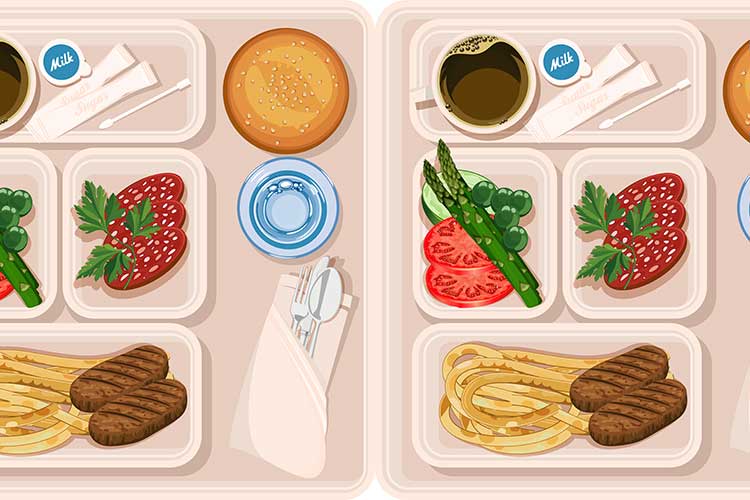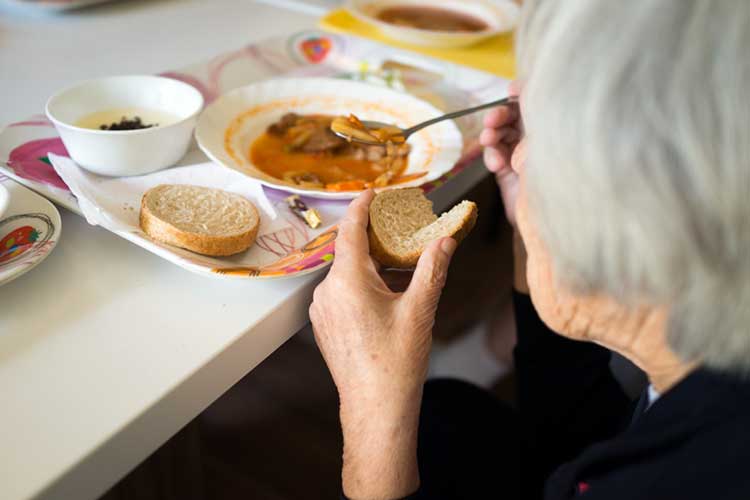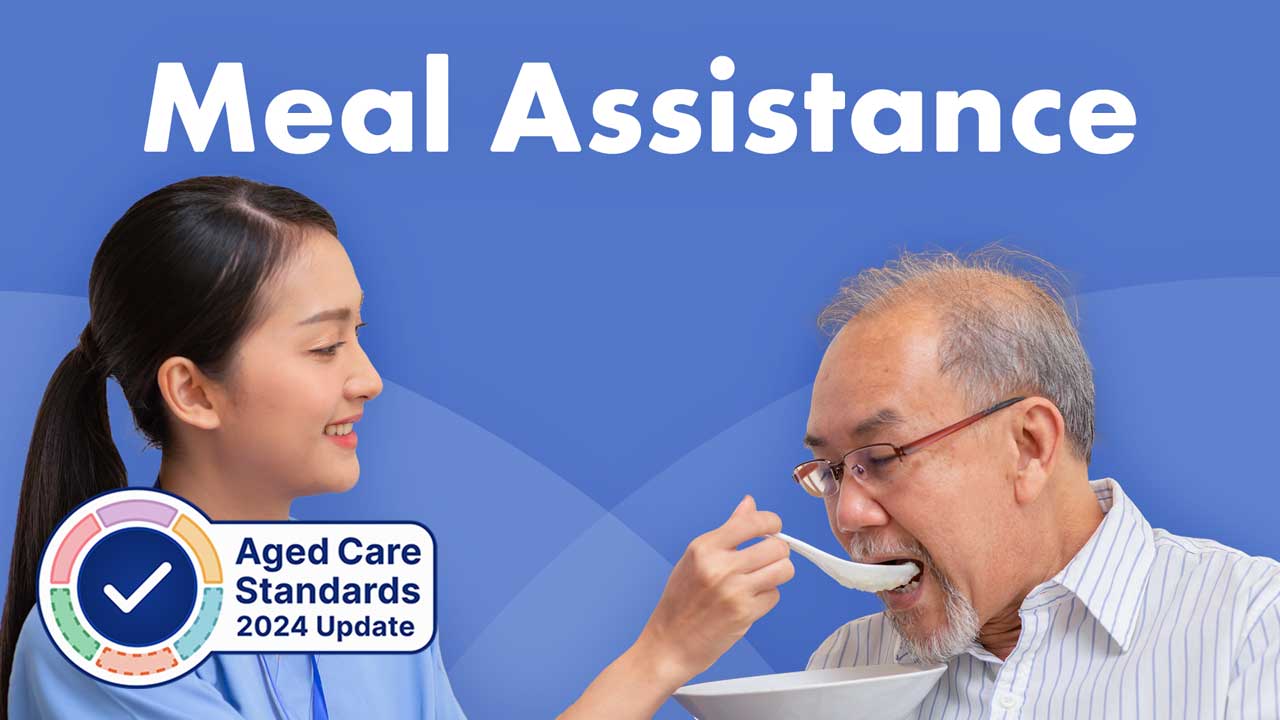Requiring assistance to eat daily meals puts residents in a vulnerable position. A great deal of tact and constant communication are needed from the healthcare staff providing this care.
There are steps you can take to make a resident’s mealtime as dignified and as seamless as possible.
Alarmingly, unplanned weight loss and malnutrition are rife among older adults in residential aged care, with about half of all aged care residents being either malnourished or at risk of malnutrition (Dietitians Australia 2023).
The reasons for this are multiple and varied. One potential cause is the poor standard of food served in Australian aged care facilities, which has been highlighted in various media reports (Blumer 2018; Stopford 2018).

Another factor to consider is that older people have weakened immune systems and may have a heightened fear of food poisoning or food complications, making them reluctant to eat food they have not prepared themselves.
One simple way to increase the likelihood of a resident receiving the nutrition they need is to play an active role in their mealtime. In doing this, you are able to observe that:
- The meal is properly cooked and prepared
- The resident is finishing the meals.
This article will outline methods of providing effective meal assistance in aged care facilities.
Meal Service Under the Strengthened Aged Care Quality Standards
Standard 6: Food and Nutrition - Outcome 6.4: Dining experience (Action 6.4.1) under the strengthened Aged Care Quality Standards requires aged care providers to support older people with eating and drinking by:
- Ensuring there are enough staff available to assist older people with eating and drinking
- Prompting and encouraging eating and drinking
- Recognising older people who require assistance to eat and drink safely
- Providing physical assistance to older people who require support to eat and drink safely.
(ACQSC 2024a)
Reasons for Needing Assistance During Meal Time
Health complications that may affect a resident’s ability to eat and drink independently include:
- Dementia or impaired cognition
- Weakness in hands or fingers due to joint pain (e.g. arthritis)
- Poor or restricted vision
- Swallowing difficulties
- Weakness or fatigue
- Other physical or cognitive impediments.
(Eat Well Nutrition 2020)

Types of Assistance
The level of assistance required by clients will vary.
This can range from:
- Supervision, prompting and encouragement
- Setting up cutlery etc.
- Cutting up meals
- Full feeding assistance.
(Eat Well Nutrition 2020)
Before the Meal
- It may seem obvious, but check that the meal is correct for the resident.
- Ensure the meal has been heated well and is the right consistency.
- Check that tables and trays are set up to suit the resident and appropriate utensils are available. Adjust these as necessary.
- Ensure that the resident has all the aids they require for mealtime, for example, dentures and glasses.
(Aged Care Guide 2014; Eat Well Nutrition 2020)

During the Meal
Communication
- Talk to the resident about the meal they’re about to eat. It is particularly important to explain what the food is when the meal has been puréed or modified to facilitate chewing/swallowing/digestion.
- Ask the residents if they would like altered utensils or any other item that would make them feel more comfortable during mealtime. Be mindful of residents’ dignity and avoid using a clothing protector unless the resident specifically requests it or it is necessary for a large volume of spillage.
- Ask the resident if there is something particular on the plate they would like to eat.
- Always let the resident know what you are doing and identify what the food is before serving it to them.
- Make conversation with the resident if appropriate.
- Refrain from talking to other people while you are assisting a resident. Do everything in your capacity to make mealtime an enjoyable experience and keep in mind that it may be a high point in the resident’s day.
(Aged Care Guide 2014; Health.vic 2016; ACQSC 2024b)
Physical Assistance
- The first step is to ensure that the resident is sitting comfortably upright and is within easy reach of their meal.
- Sit with the resident, making sure you are at their eye level and ready to assist if needed. Once they have seen the meal as it is intended to look, cut it up in front of them. Resist mixing the food together and await the resident’s instructions instead.
- Ensure the spoon is at the resident’s eye level and give them enough time to open their mouth.
- Demonstrate responsiveness to cues from the resident, such as knowing when to bring their plate closer toward them, when they are ready for the next mouthful or when they need a break.
- Serve the resident as you would yourself, including different elements of the dish. Always have water nearby to aid food intake.
(Aged Care Guide 2014; Health.vic 2016)
After the Meal
Immediately after the meal is finished, check the resident’s appearance and surroundings. For example, help remove any crumbs on their face or clothing (Elderly Health Service 2024).
Make sure the resident has finished eating before clearing their plate (ACQSC 2024b).
Make an appropriate closing remark at the end of the meal - do not simply pack up and leave without saying anything (Health.vic 2016).
If you’ve noticed that the resident is not eating or drinking enough on a regular basis, communicate this to their family and relevant supervisors and document appropriately, such as in their care plan (Aged Care Guide 2014).
Before escalating the issue, try to find out if there’s a simpler reason why they’re not eating, for example, if the food isn’t to their liking or if they would rather eat at a different time of day (Eat Well Nutrition 2020).

Be Tactful
Imagine yourself in the resident’s place and approach meal assistance with sensitivity. Bear in mind that while a person may need significant help at mealtime, there is a difference between being helpful and undermining a person’s independence. Remember that your role is to share the mealtime experience with the resident and allow them to dine with dignity (Aged Care Guide 2014).
Test Your Knowledge
Question 1 of 3
Which one of the following is an acceptable action while providing meal assistance?
Topics
Further your knowledge
References
- Aged Care Guide 2014, ‘Dignity in the Dining Room’, Aged Care Guide, 24 February, viewed 24 June 2024, https://www.agedcareguide.com.au/talking-aged-care/dignity-in-the-dining-room
- Aged Care Quality and Safety Commission 2024b, Dining in Residential Aged Care – Tips, Tricks and What to Avoid, Australian Government, viewed 24 June 2024, https://www.agedcarequality.gov.au/sites/default/files/media/p-dining_in_residential_aged_care_tips_and_tricks_fact_sheet.pdf
- Aged Care Quality and Safety Commission 2024a, Standard 6: Food and Nutrition, Australian Government, viewed 24 June 2024, https://www.health.gov.au/resources/publications/strengthened-aged-care-quality-standards-august-2025?language=en/food-and-nutrition
- Blumer, C 2018, ‘Would You Eat This? The Real Food Inside Aged Care Facilities in Australia’, ABC Investigations, 17 September, viewed 24 June 2024, https://www.abc.net.au/news/2018-09-17/food-in-aged-care/10212880
- Dietitians Australia 2023, Malnutrition, Dietitians Australia, viewed 24 June 2024, https://dietitiansaustralia.org.au/health-advice/malnutrition
- Eat Well Nutrition 2020, Mealtime Assistance, Eat Well Nutrition, viewed 24 June 2024, https://www.eatwellnutrition.com.au/preventing-malnutrition/mealtime-assistance
- Elderly Health Service 2024, Feeding Skills for Carers of Frail Elderly, The Government of the Hong Kong Special Administrative Region, viewed 24 June 2024, https://www.elderly.gov.hk/english/carers_corner/caring_skills/feeding.html
- Health.vic 2016, Assisted Eating, Victoria State Government, viewed 24 June 2024, https://www.health.vic.gov.au/dementia-friendly-environments/assisted-eating
- Stopford, A 2018, ‘Quality of Food in Aged Care Up for Discussion Again', Aged Care Guide, 13 February, viewed 24 June 2024, https://www.agedcareguide.com.au/talking-aged-care/quality-of-food-in-aged-care-up-for-discussion-again
 New
New 

